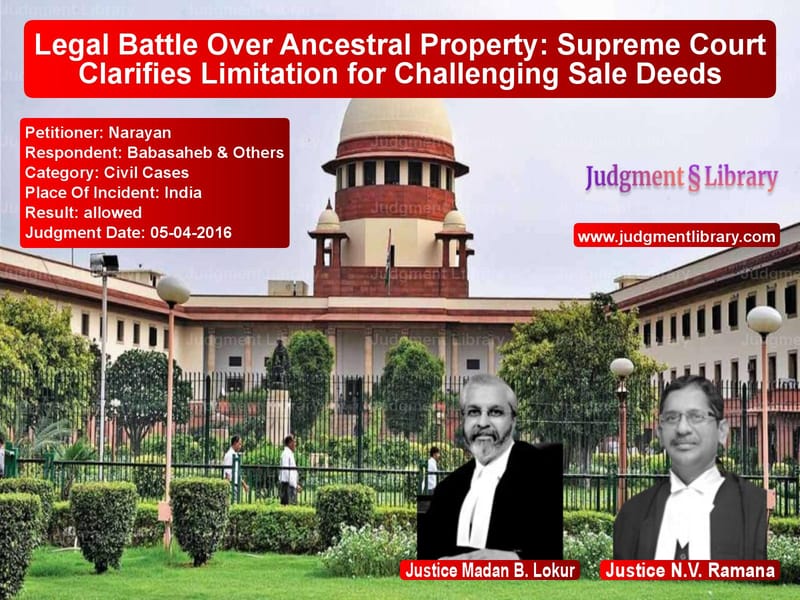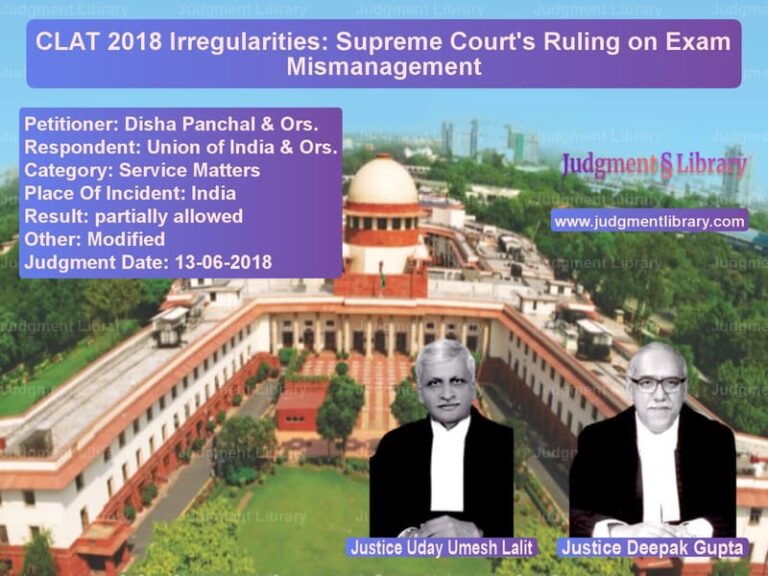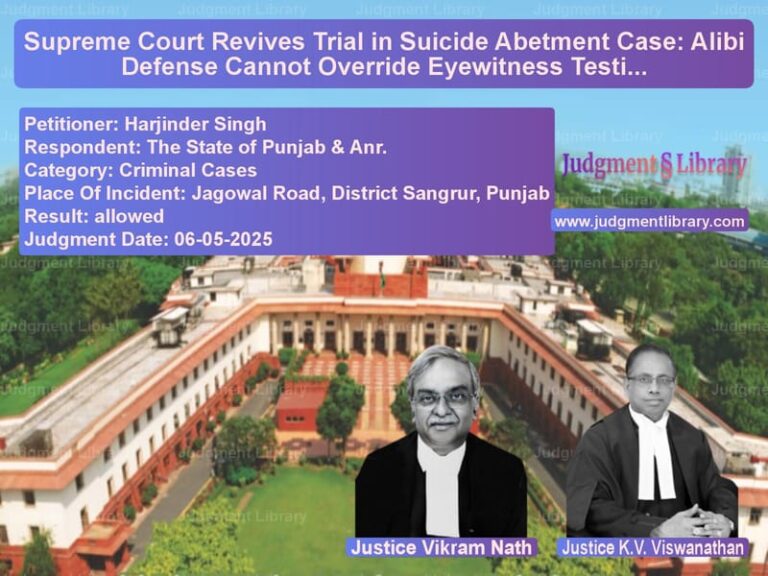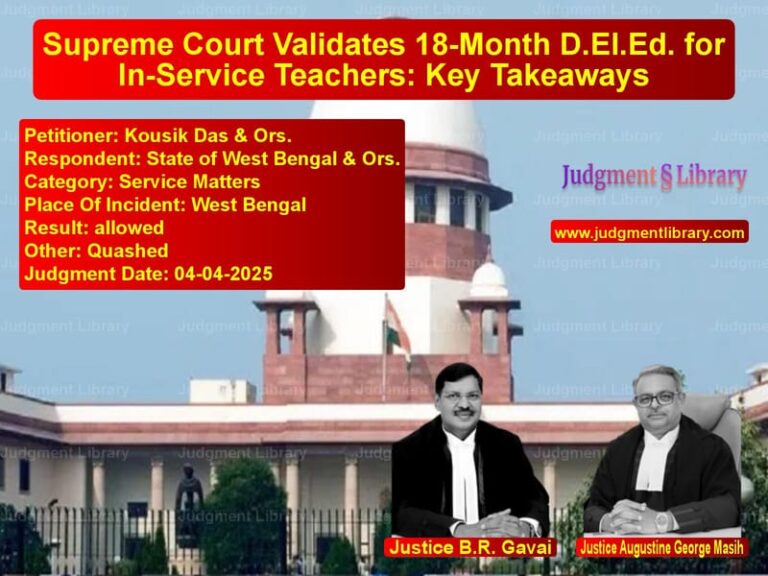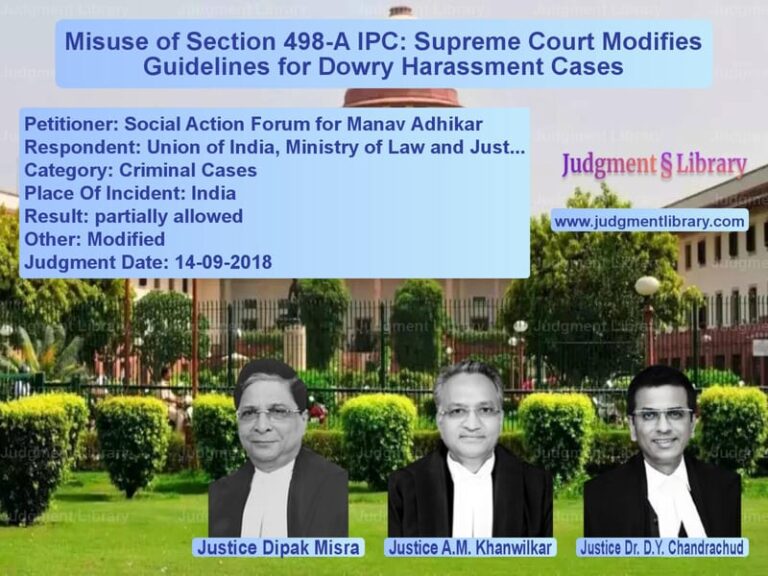Legal Battle Over Ancestral Property: Supreme Court Clarifies Limitation for Challenging Sale Deeds
The Supreme Court of India recently delivered a significant judgment in the case of Narayan v. Babasaheb & Others, which revolved around the applicability of the Limitation Act, 1963, to a suit challenging ancestral property transactions. The primary issue before the Court was whether the suit filed in 1989 to set aside a sale deed executed in 1982 was within the limitation period.
Background of the Case
The case arose from a civil suit for partition and a declaration that sale deeds dated 20.01.1982 and 28.11.1988 executed by the second defendant (the mother of the plaintiffs) were not binding. The plaintiffs sought to set aside these sale deeds, recover possession of the suit property, and claim mesne profits.
The plaintiffs contended that the property in question was ancestral, originally owned by their father, who passed away in 1972. After his death, the second defendant (their mother) allegedly alienated the property without legal necessity, thereby violating their legal rights.
Arguments by the Petitioners (Plaintiffs)
- The plaintiffs argued that the property was ancestral and that their mother, the second defendant, had no legal authority to sell it without the consent of the heirs.
- They contended that the sales were fraudulent, executed without proper consideration, and intended to deprive the legal heirs of their rightful share.
- They further argued that, as minors at the time of the sale, their rights were protected, and they were entitled to challenge the transaction upon attaining majority.
Arguments by the Respondents (Defendants)
- The first defendant (purchaser) claimed that the sale deeds were executed for legal necessity, as the mother had financial responsibilities, including marriage expenses for the daughters and maintenance of the family.
- The defendants contended that the suit was barred by limitation, citing Article 60 of the Limitation Act, which prescribes a three-year limitation from the date a minor attains majority.
- They also argued that since most plaintiffs had already attained majority by the time of filing the suit, the suit was not maintainable.
Findings of the Trial Court
The trial court ruled in favor of the plaintiffs, holding that the sale deeds executed by the mother were void under Section 11 of the Hindu Minority and Guardianship Act, 1956. The court reasoned that a de facto guardian had no authority to alienate a minor’s property unless such a sale was for legal necessity.
The trial court decreed the suit, granting partition and separate possession to the plaintiffs while recognizing their legal share in the property.
First Appellate Court’s Ruling
The first appellate court upheld the trial court’s ruling but modified the decree, stating that the first defendant (purchaser) was entitled to the share of the second defendant (mother). The appellate court rejected the limitation defense, applying Article 109 of the Limitation Act, which prescribes a twelve-year limitation for setting aside alienation by a father.
High Court’s Decision
The High Court dismissed the second appeal filed by the first defendant and ruled that Article 109 applied, as it covered alienation of ancestral property. The court held that the suit was well within limitation, affirming the decisions of the lower courts.
Supreme Court’s Analysis
The Supreme Court restricted its analysis to the question of limitation. It examined whether the plaintiffs’ suit was within the permissible time frame under the Limitation Act.
The Court referred to the relevant provisions:
- Article 60: Prescribes a three-year limitation for setting aside a transfer by a guardian, commencing from the date the minor attains majority.
- Article 109: Provides a twelve-year limitation for a Hindu governed by Mitakshara law to set aside a father’s alienation of ancestral property.
- Article 110: Provides a twelve-year limitation for a person excluded from joint family property to enforce a right to share.
The Court observed:
- The mother, as a natural guardian, was subject to the restrictions under Section 8 of the Hindu Minority and Guardianship Act, 1956, which mandates prior court permission for alienating a minor’s property.
- Since the sale was made without such permission, it was voidable, not void ab initio, and required a legal challenge within the prescribed limitation period.
- The Court held that Article 60, which applies to sales made by a guardian, was the correct provision, not Article 109, which applies to alienation by a father.
Supreme Court’s Conclusion
The Supreme Court concluded that:
- The suit was barred by limitation under Article 60, as most plaintiffs had attained majority more than three years before filing the suit.
- The lower courts erred in applying Article 109, which pertains to a father’s alienation, whereas the case involved a mother’s unauthorized sale.
- The Limitation Act does not create rights but only prescribes the period within which rights can be enforced.
- The suit should have been filed within three years of the plaintiffs attaining majority, failing which their claim became time-barred.
Accordingly, the Supreme Court allowed the appeal and set aside the judgments of the lower courts.
Impact of the Judgment
This ruling establishes key legal principles:
- A mother, as a natural guardian, cannot alienate minor property without court permission.
- Such unauthorized sales are voidable, requiring a legal challenge within the prescribed limitation.
- Claims challenging such sales must be filed within three years from attaining majority.
- The application of limitation laws is strict, and courts must interpret provisions precisely.
Conclusion
The Supreme Court’s decision clarifies the legal framework governing ancestral property transactions and the limitation period for challenging them. This judgment reinforces the principle that minors have a limited window to challenge unauthorized sales and that legal heirs must act promptly to protect their rights. It also sets a precedent for similar cases involving unauthorized alienation of ancestral property, ensuring that legal provisions are interpreted in a manner consistent with legislative intent.
Don’t miss out on the full details! Download the complete judgment in PDF format below and gain valuable insights instantly!
Download Judgment: Narayan vs Babasaheb & Others Supreme Court of India Judgment Dated 05-04-2016-1741854513653.pdf
Direct Downlaod Judgment: Direct downlaod this Judgment
See all petitions in Property Disputes
See all petitions in Succession and Wills
See all petitions in Landlord-Tenant Disputes
See all petitions in Judgment by Madan B. Lokur
See all petitions in Judgment by N.V. Ramana
See all petitions in allowed
See all petitions in supreme court of India judgments April 2016
See all petitions in 2016 judgments
See all posts in Civil Cases Category
See all allowed petitions in Civil Cases Category
See all Dismissed petitions in Civil Cases Category
See all partially allowed petitions in Civil Cases Category

